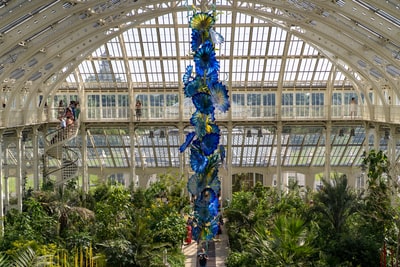 Green plants and algae are able to produce their own food using light energy. The other materials they require can be obtained from either the air or soil. Plants grow better in certain conditions and so these can be changed to optimise their development.
Green plants and algae are able to produce their own food using light energy. The other materials they require can be obtained from either the air or soil. Plants grow better in certain conditions and so these can be changed to optimise their development.
By the end of this section you should understand:
- data which shows how factors can affect photosynthesis
- the advantages to changing a plant’s environment for its growth and development
——————————————————
Photosynthesis
Photosynthesis is the chemical process used by plant and algae to make their food. The process takes place in chloroplasts, found in green plants and algae, which contain the pigment chlorophyll.
The process goes as follows:
Light energy is absorbed by the chlorophyll
?
The light energy is converted into chemical energy
?
This energy converts carbon dioxide, which was absorbed from the air, and water, which has been absorbed from the soil, into glucose
?
Oxygen is then released as a waste product back into the air
The whole process can be summarised into one equation:
light energy
carbon dioxide + water ? glucose + oxygen
——————————————————
Rate of Photosynthesis
The rate of photosynthesis can be limited by three main factors. Each of these can affect how efficiently the process is carried out.
Light intensity
If there’s not much light available then the rate of photosynthesis slows down. Even with enough water and carbon dioxide, the rate will not speed up. However, by increasing the light intensity the rate will increase as well.
Carbon dioxide
Similarly, if the amount of carbon dioxide is low, then the rate of photosynthesis will be slower no matter how good the light intensity is. Again, however, if the concentration of carbon dioxide increases so does the rate of photosynthesis.
Temperature
This can also affect the rate at which photosynthesis occurs. If the temperature is either too hot or too cold then photosynthesis will not happen. In between temperatures will increase the rate but there is one optimum temperature at which the rate of photosynthesis will be the fastest.
——————————————————
Greenhouses

Conditions can be controlled in the following ways:
- Light intensity: artificial lighting means that the plants can be exposed to light even after the sun has set. The brightness of the lighting can also be controlled so that the intensity is increased.
- Temperature: similarly, artificial heating can ensure that plants are kept within optimal heating conditions.
- Carbon dioxide concentration: extra carbon dioxide can be pumped into the greenhouse to keep it at a high level.
However, keeping plants in these conditions is not cheap. Therefore, it’s important for a farmer to weigh up the cost of the artificial lighting, heating and carbon dioxide against what extra income they’re expecting from their bigger crop yield. Generally, a farmer will want to ensure optimum growing conditions so that they can produce the best yield.
——————————————————
The Use of Glucose
Glucose is the main product produced by photosynthesis. It’s either used for respiration or converted into and stored as:
- insoluble starch,
- fats
- oils
Some glucose is also used for other reasons:
- To create cellulose which is important for the cell wall.
- To create proteins, like chlorophyll. For this, nitrates ions are also required which are absorbed from the soil.